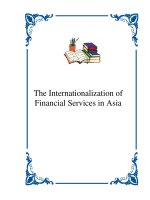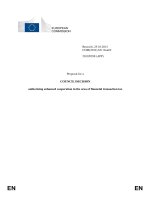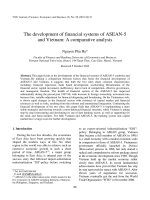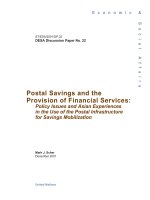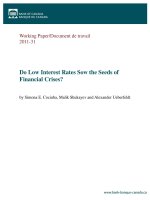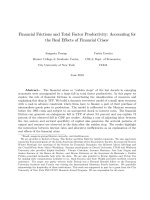Cooper the origin of financial crises (2008)
Bạn đang xem bản rút gọn của tài liệu. Xem và tải ngay bản đầy đủ của tài liệu tại đây (1.13 MB, 209 trang )
Origins_fullcover2:future storm
7/7/08
14:28
Page 1
This book has been written, in response to
the current credit crisis, to explain why the
global economy, and the US economy in
particular, finds itself caught in a seemingly
endless procession of asset price bubbles,
followed by devastating credit crunches. It
describes the processes that generate these
cycles and the reasons behind the policy
mistakes that have, of late, tended to
exacerbate them.
George Cooper
The Origin of Financial Crises provides a compelling analysis of the forces
behind today’s economic crisis. In a series of disarmingly simple arguments
George Cooper challenges the core principles of today’s economic
orthodoxy, explaining why financial markets do not obey the efficient
market principles described in today’s economic textbooks but are instead
inherently unstable and habitually crisis prone.
The author describes the evolution of our modern monetary system,
explaining along the way how financial instability emerged and why this
instability required the development of central banking. Cooper claims that
misguided faith in the power of free markets has led some central banks to
neglect their core role of managing the financial system and instead caused
them to pursue policies which promote a series of ever more violent boombust cycles. The Origin of Financial Crises calls for a radical shift in central
bank strategy, the abandonment of inflation targeting, and a paradigm shift
in our attitude to economic policy.
Along the way the reader will learn about the fundamentals of inflation and
discover what policy makers can learn from the designers of the Eurofighter
jet. They will also learn how an obscure paper on steam engines, written in
1868 by the inventor of colour photography, shows us how to avoid
repeating recent monetary policy mistakes.
Uniquely, The Origin of Financial Crises presents tangible policy proposals
aimed at helping break out of the seemingly endless procession of
damaging boom-bust cycles.
The Origin of Financial Crises
Dr. George Cooper was born in Sunderland
and studied at Durham University. He has
designed gyroscopes for guidance and
control systems, worked as a fund manager
for Goldman Sachs, as a strategist for
Deutsche Bank and most recently as the
London head of interest rate research at
JPMorgan. He lives in London with his wife
and two children.
George Cooper
The central thesis of this book is that our
financial system does not behave according
to the laws of the Efficient Market
Hypothesis, as laid down by the
conventional wisdom of today’s prevailing
economic theory. The Efficient Market
Hypothesis describes our financial system as
a docile animal that, left to its own devices,
will settle into a steady optimal equilibrium.
By contrast, this book argues our financial
system is inherently unstable, has no steady
state equilibrium and is habitually prone to
the formation of damaging boom-bust
cycles. It is argued that this instability
requires central banks to manage the credit
creation process. However, it is also
explained how central bank policy can
inadvertently slip from providing a stabilising
influence on economic activity to one that,
over time, amplifies boom-bust cycles and
destabilises our economies.
The Origin of
Financial Crises
Central banks, credit bubbles
and the efficient market fallacy
Harriman House
ISBN 9781905641857
Hh
Harri man House
George Cooper
Harriman House is one of the UK’s leading
independent publishers of financial and
business books. Our catalogue covers
personal finance, stock market investing and
trading, current affairs, business and
economics. For more details go to:
www.harriman-house.com.
Hh
Hh
£16.99
The Origin of Financial Crises
Central banks, credit bubbles and the efficient market fallacy
by George Cooper
HARRIMAN HOUSE LTD
3A Penns Road
Petersfield
Hampshire
GU32 2EW
GREAT BRITAIN
Tel: +44 (0)1730 233870
Fax: +44 (0)1730 233880
Email:
Website: www.harriman-house.com
First published in Great Britain in 2008
Copyright © Harriman House Ltd
The right of George Cooper to be identified as the author has been asserted
in accordance with the Copyright, Design and Patents Act 1988.
978-1-905641-85-7
British Library Cataloguing in Publication Data
A CIP catalogue record for this book can be obtained from the British Library.
All rights reserved; no part of this publication may be reproduced, stored in a retrieval
system, or transmitted in any form or by any means, electronic, mechanical,
photocopying, recording, or otherwise without the prior written permission of the
Publisher. This book may not be lent, resold, hired out or otherwise disposed of by
way of trade in any form of binding or cover other than that in which it is published
without the prior written consent of the Publisher.
Printed and bound in Great Britain by Athenaeum Press Limited, Tyne & Wear.
No responsibility for loss occasioned to any person or corporate body acting or
refraining to act as a result of reading material in this book can be accepted by
the Publisher, by the Author, or by the employer of the Author.
Contents
Acknowledgements
Preface
v
vii
1.
Introduction
1
2.
Efficient Markets And Central Banks?
19
3.
Money, Banks And Central Banks
39
4.
Stable And Unstable Markets
91
5.
Deceiving The Diligent
107
6.
On (Central Bank) Governors
127
7.
Minsky Meets Mandelbrot
141
8.
Beyond The Efficient Market Fallacy
155
9.
Concluding Remarks
169
Appendix – ‘On Governors’ by J.C. Maxwell
173
Index
187
iii
Acknowledgements
During my years as a fixed income analyst I have been lucky enough to
have had the opportunity to discuss, debate, and, not infrequently,
argue about financial market instability and central bank policy with
some of the financial markets’ finest analysts. I owe a broad debt of
gratitude both to former colleagues, clients and a few senior central
bankers for having helped develop and refine some of the ideas
discussed here.
For helpful suggestions on the draft manuscript I owe thanks to Philip
Maidens, Richard Williams, Dr Wendy Hamilton and Stephane Monier.
I am also eternally grateful to my wife and family for their patience
during the writing process.
v
Preface
This book has been written, in response to the current credit crisis, to
explain why the global economy, and the US economy in particular,
finds itself caught in a seemingly endless procession of asset price
bubbles, followed by devastating credit crunches. It describes the
processes that generate these cycles and the reasons behind the policy
mistakes that have, of late, tended to exacerbate them.
My aim is to bring an understanding of financial instability and central
banking to as wide an audience as possible in the hope that this will
bring with it an informed discussion of how macroeconomic policy
should be reformed. If we are to break out of this damaging cycle of
booms and busts, all participants in the economy must recognise the
proper role and limitations of macroeconomic policy. Politicians and
voters must acknowledge that it is neither possible nor desirable to use
fiscal and monetary policy to immediately counteract any and all
economic downturns. Central banks must return to their core purpose
of managing the credit creation process and must learn to resist political
and private sector pressure for an endless credit-fuelled economic
expansion.
The central thesis of this book is that our financial system does not
behave according to the laws of the Efficient Market Hypothesis, as
laid down by the conventional wisdom of today’s prevailing economic
theory. The Efficient Market Hypothesis describes our financial system
as a docile animal that, left to its own devices, will settle into a steady
optimal equilibrium. By contrast, this book argues our financial system
is inherently unstable, has no steady state equilibrium and is habitually
prone to the formation of damaging boom-bust cycles. It is argued that
vii
The Origin of Financial Crises
this instability requires central banks to manage the credit creation
process. However, it is also explained how central bank policy can
inadvertently slip from providing a stabilising influence on economic
activity to one that, over time, amplifies boom-bust cycles and
destabilises our economies.
It will be argued that the US Federal Reserve has inadvertently slipped
into a mode of monetary policy that is generating a series of ever-larger
credit cycles and which, if continued, will significantly impair the
prospects of what is still the world’s most important and most vibrant
economy.
George Cooper, April 2008
viii
1
Introduction
1.1 Lopsided Policy
T
he first years of this millennium were marred with a corporate
credit crisis; this being the hangover of a credit binge associated
with the stock market boom of the late 1990s. Just as this crisis ebbed
we found ourselves engulfed in a housing boom and, sure as night
follows day, this boom has now morphed into its inevitable credit
crunch. The proximity of these boom-bust cycles has fuelled the popular
perception that financial crises are becoming larger and more frequent.
The following chapters will explain why this popular perception is
correct.
Toward the end of the book I make some policy suggestions that, it is
hoped, could begin to dampen the current chain of overlapping boombust cycles. The overall thrust of these suggestions is that avoiding the
financial tsunamis comes at the price of permitting, even encouraging,
a greater number of smaller credit cycles. And also at the price of
requiring central banks to occasionally halt credit expansions. That is
to say, the central banks must be required to prick asset price bubbles.
Key to the success of any such policy will be a political climate that
accepts the need for symmetric monetary policy; excessive credit
expansion should be fought with the same vigour as is used to fight
excessive credit contraction. As things stand neither politicians nor
voters are ready for such tough love and central bankers have neither
the stomach nor inclination to deliver it. In large part this is because
economists have taught us that it is unwise and unnecessary to combat
asset price bubbles and excessive credit creation. Even if we were unwise
enough to wish to prick an asset price bubble, we are told it is
impossible to see the bubble while it is in its inflationary phase. We are
told, however, that by some unspecified means the bubble’s camouflage
is lifted immediately as it begins deflating, thereby providing a trigger
for prompt fiscal and monetary stimulus.
3
The Origin of Financial Crises
In recent years this lopsided approach to monetary and fiscal policy has
been further refined into what has been described as a “risk
management paradigm”, whereby policy makers attempt to get their
retaliation in early by easing policy in anticipation of an economic
slowdown, even before firm evidence of the slowdown has been
accumulated. This strategy is perhaps best described as pre-emptive
asymmetric monetary policy.
To followers of orthodox economic theory, based on the presumption
of efficient financial markets, this new flavour of monetary policy can
be justified. Yet, current events suggest these asymmetric policies have
gone badly wrong, leading not to a higher average economic growth
rate, as was hoped, but instead to a an unsustainable level of borrowing
ending in abrupt credit crunches.
1.2 Efficient Markets – More Faith Than Fact
The bare outlines of a competitive profit-and-loss system are
simple to describe. Everything has a price – each commodity and
each service. Even the different kinds of human labor have prices,
usually called ‘wage rates.’
Everybody receives money for what he sells and uses this money
to buy what he wishes. If more is wanted of any one good, say
shoes, a flood of new orders will be given for it. This will cause
its price to rise and more to be produced. Similarly, if more is
available of a good like tea than people want, its price will be
marked down as a result of competition. At the lower price
people will drink more tea, and producers will no longer produce
so much. Thus equilibrium of supply and demand will be
restored.
4
Introduction
What is true of the markets for consumers’ goods is also true of
markets for factors of production such as labor, land, and capital
inputs.
Paul A Samuelson1
Who could possibly argue with the above passage? It was written by
one of the world’s most respected economists and is no more than a
statement of the common-sense principle of supply and demand. When
the demand for a particular product goes up, so does its price, which is
then followed by an increase in supply. According to this theory, prices
jostle up and down keeping supply and demand in perfect balance. With
just a little more thought we can stretch the argument further and
convince ourselves not only that this process generates a stable
equilibrium state, but that it also ensures the best possible arrangement
of prices, leading to the optimal allocation of resources; if a better,
more-economically productive, allocation of resources could be
achieved, then those able to make better use of the resources would be
able to pay more for them, causing prices to change accordingly.
Naturally, if markets tend toward an optimal arrangement of prices,
with the most productive allocation of resources, this configuration
must also be a stable equilibrium situation. The upshot of all of this is
what is known as the laissez-faire2 school of economic theory, which
argues that market forces be given free rein to do as they choose. The
logic of the laissez-faire school being that, if free markets naturally
achieve an optimal equilibrium, any interference with market forces can
at best achieve nothing, but more likely will push the system away from
equilibrium toward a sub-optimal state. The prevailing laissez-faire
1
“Economics, An Introductory Analysis” Paul A. Samuelson, p39, fourth edition.
2
A French phrase meaning ‘let do’ which has been adopted as a shorthand phrase implying a
strategy of allowing markets to operate with complete freedom, unhindered by any form of
management, regulation or other government interference.
5
The Origin of Financial Crises
school therefore requires the minimization, even elimination, of all
forms of interference with the operation of market processes.
It also follows from the efficient market philosophy that only external
adverse shocks are able to push markets away from their natural optimal
state, as, by definition, an equilibrium-seeking system cannot internally
generate destabilising forces able to push it away from equilibrium.
1.3 A Slight Of Hand
Now re-read Samuelson’s passage, only this time look out for the slight
of hand in the final sentence:
What is true of the markets for consumers’ goods is also true of
markets for factors of production such as labor, land, and capital
inputs.
The passage provides a convincing explanation of how equilibrium is
established in the marketplace for goods, but when it comes to the
markets for labour, land and capital inputs, there is no explanation of
the mechanisms through which equilibrium is established. For these
markets we are offered nothing better than proof by assertion. This
logical trick is pervasive in economic teaching: we are first persuaded
that the markets for goods are efficient, and then beguiled into believing
this to be a general principle applicable to all markets. As the failure of
Northern Rock and Bear Stearns show it is unsafe to assume that all
markets are inherently stable.
1.4 The Market For Bling
We can easily find a counter example to Samuelson’s well-behaved
supply-and-demand driven markets. In the marketplace for fine art and
6
Introduction
luxury goods, demand is frequently stimulated precisely because supply
cannot be increased in the manner required for market efficiency: Who
would pay $140,000,000 for a Jackson Pollock painting if supply could
be increased in proportion to demand? The phrase “conspicuous
consumption” was coined by the economist Thorstein Veblen to
describe markets where demand rose rather than declined with price.
Veblen’s theory was that in these markets it was the high price, the
publically high price, of the object that generated the demand for it.
Veblen argued that the wealthy used the purchase of high-priced goods
to signal their economic status.3 Veblen was the original economist of
bling – if you’ve got it you want to flaunt it.
Fortunately for the high priests of market efficiency, Veblen’s
observations can be dismissed as minor distortions within an overall
economic environment that responds in a rational manner to higher
prices. That is to say, even at a price of $140,000,000, the market for
Jackson Pollock paintings is irrelevant to the wider economy.
1.5 When The Absence Of Supply Drives Demand
While the markets for bling can be dismissed as economically irrelevant,
there are other much more important markets which also defy the laws
of supply and demand, as described by Samuelson. While Veblen
identified the rare conditions in which high prices promoted high
demand, we can also consider the much more common situation in
which low or falling supply promotes high demand.
Today’s oil markets are a case in point, where constrained supply is
prompting higher speculative demand. While consumers of oil are
reducing their oil purchases in response to supply constraints and higher
3 “The Theory of the Leisure Class” Thorstein Veblen, first published 1899.
7
The Origin of Financial Crises
prices, speculators (investors) in oil are moving in the opposite direction
and increasing their purchases.
This simple observation of how consumers and speculators respond in
different ways to supply constraints gives us the first hint that a
fundamentally different market mechanism operates in the markets for
assets to that which dominates the markets for goods and services. This
effect is not confined just to today’s unusual oil market: Who would
invest in the shares of a company if that company were in the habit of
issuing more stock whenever its share price rose above a certain level?
As a rule, when we invest we are looking for an asset with a degree of
scarcity value, one for which supply cannot be increased to meet
demand. Whenever we invest in the hope of achieving capital gains we
are seeking scarcity value, in defiance of the core principle that supply
can move in response to demand.
To the extent that asset price changes can be seen as a signal of an asset
becoming more or less scarce, we can see how asset markets may behave
in a manner similar to those of Veblen’s market for conspicuous
consumption goods. In Veblen’s case it is simply high prices that
generate high demand, but in asset markets it is the rate of change of
prices that stimulates shifting demand.
Frequently in asset markets demand does not stimulate supply, rather
a lack of supply stimulates demand. Equally price rises can signal a lack
of supply thereby generating additional demand, or, conversely, price
falls can signal a glut of supply triggering reduced demand.
8
Introduction
1.6 Introducing The Efficient Market Hypothesis
To economists the importance of efficient markets lies not in the
markets’ pricing mechanism directly, but rather in the ability of the
pricing mechanism to maximise economic output via an optimal
allocation of resources. To financial professionals the emphasis is more
directly on the pricing of the items being traded. Financial theory has
refined and extended the implications of market efficiency into an
additional set of laws describing how markets must behave as a
consequence of their being efficient.
The key message of the Efficient Market Hypothesis is that asset prices
are always and everywhere at the correct price. That is to say, today’s
market prices, no matter what they are, correctly reflect assets’ true
values, based on both current economic conditions and the best estimate
of how those conditions will evolve in the future. According to this
financial theory any asset price movement must be generated by
external “shocks”. To the efficient market school the constant price
changes observed in financial markets are the result of those markets
responding to a constant stream of new information.
The Efficient Market Hypothesis has no room for asset price bubbles
or busts; under this theory the wild asset price swings commonly
referred to as bubbles are nothing more than markets responding to
changing fundamentals. People outside of the world of economics and
finance may be amazed to know that a significant body of researchers
are still engaged in the task of proving that the pricing of the NASDAQ
stock market correctly reflected the market’s true value throughout the
period commonly known as the NASDAQ bubble. To these researchers
the NASDAQ Composite Index was correctly priced at 1,140 in March
1996, also correctly priced at 5,048 in March 2000, and again correctly
priced when, in October 2002, it had returned to a price of 1,140. The
9
The Origin of Financial Crises
intellectual contortions required to rationalize all of these prices beggars
belief, but the contortions are performed, none the less, in the name of
defending the Efficient Market Hypothesis.4
The idea that markets are always correctly priced remains a key
argument against central banks attempting to prick asset price bubbles.
Strangely, however, when asset prices begin falling the new lower prices
are immediately recognised as being somehow wrong and requiring
corrective action on the part of policy makers.
Another interesting result of the Efficient Market Hypothesis is that it
can be used to infer the manner in which asset prices move, which in
turn allows for the calculation of the entire probability distribution of
potential future asset returns. Sadly, these theoretical distributions tend
not to fit with the reality of financial markets, which in practice tend to
generate extremes of both positive and negative returns that simply
cannot be explained with the statistical models derived from the
Efficient Market Hypothesis. The clash between the theoretical statistics
predicted by efficient markets and those observed within real financial
markets is known as the “fat tails” problem.5 One recent example of the
fat tail problem occurred with huge losses in one of the world’s largest
hedge funds. These losses were apparently described by the firm’s chief
financial officer as resulting from the fund suffering adverse “25standard deviation events, several days in a row”. It is difficult to
convey just how improbable a pair of back-to-back 25-standard
4
See “Was there a Nasdaq bubble in the late 1990s?” L Pastor, Pietro Veronesi, Journal of Financial
Economics, Vol 81, Issue 1, July 2006. The paper’s answer to the question posed in its title: ‘Not
necessarily: a firm’s fundamental value increases with uncertainty about average future profitability,
and this uncertainty was unusually high in the late 1990s’ – Apparently we should pay more for
companies about which we know less! One suspects this wisdom has yet to reach Warren Buffett.
5
The term “fat tails” refers to the tendency for distributions of asset returns not to follow bellshaped “normal” distribution curves, but instead to have an excess of events recorded in wings
or tails of the distribution. Frequently asset return distributions look quite unlike normal
distributions and can often be double peaked.
10
Introduction
deviation losses really is, but by my estimate its probability is roughly:
0.0000000000000000000000000000000000000000000000000000000
000000000000000000000000000000000000000000000000000000000
000000000000000000000000000000000000000000000000000000000
000000000000000000000000000000000000000000000000000000000
0000000000000000000000000000000000000000000000001.
Statistically speaking, a pair of 25-standard deviation events is not an
example of bad luck; it’s an example of bad statistics and bad science.
Improbabilities such as these properly belong to the realm of Douglas
Adams.
Were these claimed 25-standard deviation events unique, it would be
possible to gloss over the inconsistencies between real life and
theoretical forecasts, but in finance statistical impossibilities are quite
literally an everyday occurrence. Each and every day financial markets
move in ways that simply cannot be explained by our theories of how
these markets work.
Nevertheless, despite overwhelming evidence to the contrary, the
Efficient Market Hypothesis remains the bedrock of how conventional
wisdom views the financial system, the key premise upon which we
conduct monetary policy and the framework on which we construct
our financial risk systems.
1.7 We Already Have A Better Theory
Fortunately, there is an alternative theory of how financial markets
operate, one that is fully able to explain the credit crunch we are now
witnessing, and one that, with a little thought, can also explain the
erratic behaviour of financial markets. The theory in question is the
Financial Instability Hypothesis, developed by the American economist
11
The Origin of Financial Crises
Hyman P Minsky. Minsky himself credited many of his ideas to another
great economist John Maynard Keynes, whose famous 1936 book “The
General Theory of Employment, Interest and Money” provided a
comprehensive refutation of the idea of efficient markets.
Among my collection of obscure and unfashionable economics books I
have one written, in 1975, by Hyman Minsky titled simply “John
Maynard Keynes”. My copy of this book, which is now out of print, is
stamped on the top, bottom and inside cover, with the words
‘DISCARDED’ in bright red letters. According to its markings the book
comes from the Erie City & County Library, Pennsylvania, where it sat
largely unread since 1977.
Discarded is a fair way to describe how the finance and economics
communities have, up until very recently, treated Minsky’s Financial
Instability Hypothesis and Keynes’ refutation of efficient market theory.
For now, conventional wisdom remains with the Efficient Market
Hypothesis; however, this latest financial turmoil has shaken at least
some of the faithful and the term “Minsky Moment” has now made its
way into the popular press as a phrase describing the point at which a
credit cycle suddenly turns from expansion to contraction.
In the following chapters I hope to bring some of Minsky’s wisdom to
a wider audience and show how the processes he identified fall easily
into agreement with the behaviour of real financial markets.6 At the
same time I aim to highlight some of the logical inconsistencies in what
passes for today’s conventional wisdom on matters of macroeconomic
policy, while also explaining how these inconsistencies have resulted in
dangerously destabilising monetary policy.
6
While I believe I have stuck to the spirit of Minsky’s message I have not slavishly followed the
details of how he presented his arguments, which are at times unnecessarily technical for a wider
audience. I should also note that many of the essentials of Minsky’s theory had already been
presented by Irving Fisher in 1933 and, according to Minsky, also by Keynes in 1936.
12
Introduction
1.8 Internal Or External?
The key difference between the Efficient Market Hypothesis and
Minsky’s Financial Instability Hypothesis comes down to the question
of what makes the prices within financial markets move. As discussed,
efficient market theory says that markets move naturally only toward
equilibrium, and after reaching equilibrium they remain in this
quiescent state until influenced by a new, unexpected, external event.
The emphasis here is on the external nature of the force causing
financial markets to move. By contrast, Minsky’s Instability Hypothesis
argues that financial markets can generate their own internal forces,
causing waves of credit expansion and asset inflation followed by waves
of credit contraction and asset deflation.
The implications of Minsky’s suggestion are that financial markets are
not self-optimising, or stable, and certainly do not lead toward a natural
optimal resource allocation. In short, Minsky’s arguments attack the
very foundation of today’s laissez-faire economic orthodoxy, as did
those of Keynes before him.
Answering the question of whether or not Minsky is correct boils down
to the challenge of identifying processes, internal to the financial
markets, which may build upon themselves becoming strong enough to
push the markets away from any given equilibrium position. If
processes such as these can be identified, then the Efficient Market
Hypothesis must be rejected and with it today’s accepted wisdom on
how to conduct macroeconomic policy.
Two internally-generated destabilising forces have already been
introduced in the form of: supply, or the lack thereof, as a driver of
demand in asset markets; and asset price changes as a driver of asset
demand. The bulk of the rest of the book will follow Minsky’s lead and
focus on explaining the much more powerful destabilising forces
13
The Origin of Financial Crises
generated within the banking system and the credit creation process
broadly.
1.9 Money Market Funds – A Banking System In
Miniature
In the US, money market mutual funds are a common feature of the
financial landscape. Many of these funds are what is known as “stabledollar” funds, and are constructed to mimic the behaviour of traditional
bank current accounts.
To investors, these stable-dollar money market funds appear to walk
and talk like any ordinary bank account. Cash can be paid into, and
withdrawn from, the funds on a daily basis, and any holdings within the
fund accrue interest each day. As with any bank account, investors in
stable-dollar money market funds expect to get back the money they
have paid into the fund plus interest. As for bank accounts, where it is
considered unacceptable to lose or fail to repay a depositor's money on
demand, in these funds also losses, or the failure to return an investor’s
cash on demand, are considered unacceptable.
The object of stable-dollar money market funds is to provide its
investors with a rate of interest usually available only on longer-term
deposit accounts, while at the same time giving investors instant access
to their cash.7
7
In the money markets it is normal to receive higher rates of interest when committing to deposit
funds for longer periods. Typically savers wanting instant access to their cash will receive the
lowest rates of interest while those willing to deposit money for a few months at a time will receive
a higher interest rate. The interest rates offered even on deposits of just a few months are often
substantially higher than overnight rates.
14
Introduction
1.9.1 Stable dollar US money market funds – as banks
The little bit of financial alchemy which gives investors both high
interest and instant access to their cash works as follows: many small
individual investors treat the fund like a bank deposit account, making
small deposits and withdrawals each day. On most days the investors’
deposits and withdrawals more or less cancel each other out, leaving the
fund’s overall assets roughly unchanged from one day to the next. The
individual investors see constantly moving streams of money, whereas
the fund manager sees a largely stagnant, and therefore investable, pool
of money. The managers are able to use the statistical averaging of the
fund’s flows for the benefit of the fund’s investors.
Usually only a small fraction of the fund’s balance is ever in active use
at any one time. This fraction is kept at hand to meet the ebb and flow
of the investors’ deposits and withdrawals. The rest of the money is lent
out through the commercial money markets, typically for several
months at a time. By lending the money for longer periods the fund
manager is able to earn higher interest rates for the clients of the fund.
As a result the shareholders enjoy both instant access to their funds and
the higher interest rates of term deposits.8 This all works fine until the
moment comes when a large number of investors decide to ask for their
money back at the same time.
1.9.2 Conflicted objectives
Each day these funds calculate the average interest rate earned on all of
their loans, and from these calculations work out what rate of interest
the funds can afford to pay their investors. These rates are available for
the funds’ investors and potential investors to inspect on a daily basis.
8
To be precise they enjoy higher term deposit rates only on that fraction of the fund’s money that
the manager feels comfortable in investing for longer periods, though this is typically more than
90% of the fund’s assets.
15
The Origin of Financial Crises
The US money market fund business is an intensely competitive
industry, producing a constant pressure on fund managers to offer the
best possible interest rates. Those funds consistently offering
uncompetitive interest rates quickly find their investors withdrawing
their cash and placing it into competitor funds offering higher rates.
In money markets, as with most debt markets, the way to earn the
highest rates of interest is to make loans for the longest possible periods
to the lowest quality, least-reliable investors. The pressure for high
money market yields therefore encourages fund managers toward a
high-risk lending strategy. But this strategy runs into direct conflict with
the money market fund’s commitment to give back all of the investor’s
money, plus interest earned, without the risk of losses.
1.9.3 An introduction to bank runs
In the event of a loan defaulting within one of these money market
funds, the fund manager must calculate the effective interest rate on
that particular loan as negative – in effect spreading the loss of the loan
out over the remainder of its original life and allocating that loss
proportionately across all of the deposits in the fund. In this way, even
small defaults could reduce the fund’s average yield considerably,
thereby encouraging some investors to withdraw their funds. As a result
of these withdrawals the fund manager will be forced to reallocate the
losses across the now smaller pool of remaining investors. The loyal
investors will then suffer an even lower interest rate, which in turn will
cause further investor defections and a still heavier allocation of losses
to the remaining truly faithful investors. What may have started as a
minor default, affecting only a tiny fraction of the fund’s assets, can
quickly spiral into a self-fulfilling cycle of withdrawals. The end result
of which is to leave the last few investors holding all of the losses – in
financial markets loyalty frequently does not pay.
16


